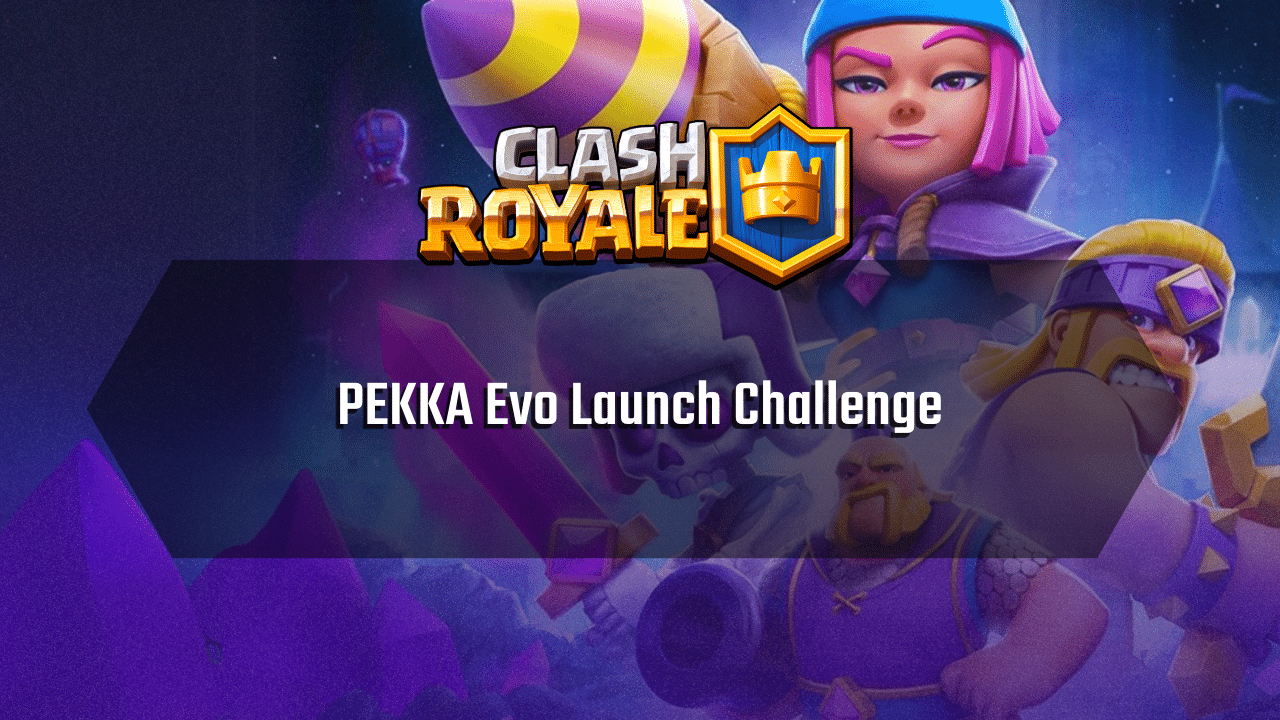Clash Royale PEKKA Evo Launch Challenge - Theria Games

Introduction to the PEKKA Evo Launch Challenge
The Clash Royale PEKKA Evo Launch Challenge kicks off Season 63, running from September 2nd to September 8th, 2024. Players can experience the new Evo Pekka, a key feature of this event, by including it in their decks.
The Evo Pekka, while retaining the same base stats as the original Pekka, offers a unique and powerful ability: it heals some of its health each time it successfully defeats an enemy unit or tower. The event offers various ways to participate, including a casual game mode where players can enjoy multiple losses while continuing to play, as well as a more competitive event challenge with a limit on the number of losses (usually up to three) before elimination. This makes it a thrilling opportunity for players to test out the new card in both casual and high-stakes settings.
Understanding the Evolved PEKKA
The Evolved PEKKA is a new card evolution introduced in Clash Royale during the PEKKA Evo Launch event. It is a one-cycle Evolution, meaning that after unlocking the evolution, every subsequent PEKKA card you play will be the evolved version. The Evo Pekka retains the same base stats as the normal Pekka, but its standout feature is its unique healing ability. The healing blade allows it to restore 12.5% of its health whenever it delivers the killing blow to an enemy unit or tower.
This healing mechanic makes the Evo Pekka particularly effective against swarm units, as it can heal back significant portions of health while clearing multiple smaller troops. In certain situations, if the Evo Pekka is at full health, the healing can even increase its total hit points, potentially surpassing the Golem’s health as it continues to eliminate enemies. This makes the Evo Pekka a strong defensive unit and a persistent threat on offense. However, the healing only activates when the Evo Pekka deals the final blow to an enemy, meaning it won’t heal if it simply damages the unit.
While the Evo Pekka is powerful due to its healing and damage output, it is not typically used as a standalone win condition, as it can easily be distracted by enemy units. For this reason, it is often paired with other win conditions in decks. The Evo Pekka also has counters that can shut it down, such as the Inferno Tower, Inferno Dragon, and Evolved Skeleton. While it handles small swarms more effectively than its normal counterpart, larger swarms, like the Skeleton Army, can still overwhelm it, making strategic placement and support crucial for maximizing its potential.
Challenge Structure and Rewards
The PEKKA Evo Launch Challenge is a special event where players must use decks that include the mandatory Evolved PEKKA to secure victories. As players progress through the challenge, they are rewarded with exclusive items for reaching various milestones. For example, achieving 10 wins grants players an exclusive Banner.
The event offers two main ways to participate. The first is a general game mode, available throughout the event from September 2nd to 8th, 2024, where players can continue battling regardless of how many losses they incur. The second is a more competitive event challenge, which starts on September 6th, 2024, and has a limit on the number of losses allowed, typically three losses leading to elimination. This event challenge offers exclusive banners and tokens as rewards for winning.
In the general game mode, players can earn Season Tokens through various in-game actions. For each match, players earn:
50 Season Tokens for defending each Crown Tower (up to a maximum of 150 per match),
100 Season Tokens for destroying each enemy Crown Tower (up to a maximum of 300 per match),
1 Season Token for each elixir spent during a match,
1.5x the total amount of Season Tokens earned for the winner of the match.
There is a daily limit of 1000 Season Tokens that players can earn from these activities. Additionally, players who complete the event challenge by achieving the required number of wins before reaching the loss limit will receive exclusive banners and a further amount of tokens as rewards.
Key Deck Building Strategies for the Challenge
In the PEKKA Evo Launch Challenge, since the Evo Pekka is a mandatory inclusion in your deck, the key to success lies in selecting the remaining seven cards that best complement its strengths and mitigate its weaknesses.
One important strategy is to prioritize a secondary win condition. While the Evo Pekka is powerful, it is not a reliable win condition on its own because it can be easily distracted. Therefore, it’s essential to include at least one other dedicated win condition. Effective options include the Balloon, which pairs well with Lumberjack and Freeze for aggressive pushes, the Battle Ram for bridge pressure, the Hog Rider in cycle decks for quick attacks, or even Graveyard or Goblin Drill as alternative win conditions.
Next, you should include anti-swarm cards. While the Evo Pekka’s healing ability helps against swarms, larger swarm units can still overwhelm it. Cards like Arrows, Zap, Log, and Tornado can effectively manage these threats, with the Tornado also synergizing well to group units for easier targeting by your spells or Evo Pekka. Additionally, cards like Ice Wizard and Baby Dragon provide area damage to control swarms and smaller units.
Another essential strategy is to address Pekka counters. Cards like Inferno Tower and Inferno Dragon are prominent counters to the Evo Pekka, so it’s crucial to include cards that can either distract or eliminate these threats. Consider using cards that can handle these counters or focus on alternative win conditions that are less vulnerable to them. The Cannoneer could also be useful against both regular Pekka and Evo Pekka.
Maintaining a reasonable elixir cost and cycle is another important consideration. The Evo Pekka itself costs 7 elixir, so a deck with a manageable average elixir cost will allow for consistent cycling and defensive flexibility. Decks with lower average elixir costs can cycle back to the Evo Pekka more frequently, which is especially helpful as it’s a one-cycle evolution. In general, playing defensively during single elixir and capitalizing on elixir advantages during double and triple elixir can be a strong strategy.
Lastly, don’t forget to consider your deck’s defensive capabilities. Since the Evo Pekka can serve as a strong defensive unit, your deck should be able to support it on defense and transition smoothly into a counter-push. Cards like Royal Ghost, Bandit, and Electro Spirit can provide both defensive utility and offensive pressure. Additionally, defensive spells like Freeze can protect your units and towers from threats.
The Tower Troop you choose also influences your defensive strategy. Cannon and Tower Princess are good options to help manage specific threats. For example, the Cannon can effectively handle regular Pekka and is a solid defensive option against various heavy tanks.
By incorporating these strategies and experimenting with deck combinations, you can build a well-rounded deck to tackle the PEKKA Evo Launch Challenge, adapting to the evolving meta and improving your chances for success.
Examples of Recommended Decks
Several effective deck archetypes featuring the Evolved PEKKA have proven successful in the PEKKA Evo Launch Challenge. Here are some key examples of decks and their components:
One popular archetype is the Pekka Lumberloon Freeze Deck, which focuses on a defensive early game and aims to control enemy pushes until double elixir time. The Lumberjack and Balloon combination serves as the primary win condition, often supported by the Freeze spell to secure tower damage. The Evo Pekka acts as a powerful defensive unit with its healing ability.
Supporting cards for this deck include Evo Zap, Tornado, Ice Wizard, Baby Dragon, Cannon (or Tower Princess as an alternative Tower Troop). The strategy involves defending in single elixir and launching aggressive Lumberloon Freeze pushes later on, with Freeze spells used defensively to prevent enemy tower damage.
The Pekka Battle Ram Bridge Spam Deck is another effective option, known for applying constant pressure with troops spammed at the bridge. The Evo Pekka acts as a strong defensive backbone and transitions into a counter-push. The Battle Ram is the main win condition to target enemy towers. Supporting cards for this deck include Evo Wizard, Electro Spirit, Arrows, Royal Ghost, Bandit, and Cannoneer (as a Tower Troop). The strategy centers around maintaining lane pressure with spammy cards and using the Evo Pekka to shut down beatdown win conditions. The Royal Ghost can be placed in front of the Battle Ram to clear swarms.
Another variant is the Pekka Poison Bridge Spam Deck, which uses Poison for direct tower damage and control, in addition to bridge spam tactics. Similar to the Battle Ram deck, it features the Evo Pekka as a central defensive unit, with Battle Ram, Royal Ghost, and Bandit providing offensive pressure. Other key supporting cards include Evo Zap, Magic Archer, and Electro Wizard. The strategy revolves around aggressive bridge pushes, using Poison for chip damage, and leveraging the Electro Wizard to win trades and control the battlefield.
The Fast Cycle Pekka Deck with Lumberjack Balloon emphasizes quickly cycling cards to set up Lumberjack Balloon pushes, with the Evo Pekka primarily used for defense. Key components include Lumberjack, Balloon, Freeze, Ice Spirit, Guards (for distraction), Phoenix (for countering enemy Pekkas and aerial support), and Zap or Evo Zap. This deck aims for counter-pushing and capitalizing on elixir advantages to launch aggressive Lumberjack Balloon Freeze attacks.
These deck examples highlight the Evolved PEKKA’s versatility and how it can be integrated into various archetypes for success in the challenge. By experimenting with different combinations, players can tailor their deck to fit their playstyle and increase their chances of winning.
Key Gameplay Tips for Success
To succeed in the PEKKA Evo Launch Challenge, players should focus on several key gameplay strategies that revolve around utilizing the strengths of the Evolved PEKKA while mitigating its weaknesses.
First, cycle your Pekka to reach the Evo version efficiently. Since the Evo Pekka is a one-cycle evolution, every other Pekka played will be the evolved version. This is essential for ensuring the Evo Pekka is available when needed, especially for defending against large pushes.
The Evo Pekka’s healing ability is one of its defining features. It heals itself by 12.5% of its health each time it delivers the killing blow to an enemy unit or tower. This makes it especially effective against swarm units, as it can regenerate health after each kill. It’s crucial to let the Evo Pekka get the killing blow in order to trigger its healing, and if it gets multiple kills, it can even exceed its maximum health, becoming a formidable presence on the battlefield.
For certain decks, such as the Lumberloon Freeze variant, it’s often best to play defensively in single elixir time. The goal is to survive until double or triple elixir when you can launch stronger attacks. In this setup, let your opponent make the first move and counter-attack, focusing on surviving until you can gain a decisive elixir advantage.
In Lumberloon Freeze decks, learning how to execute a Lumberloon Freeze push effectively is key. This push often requires just one successful execution to win the game, but it’s important not to waste a Lumberjack Balloon early in the match. Instead, focus on counter-pushing when you have an elixir advantage to ensure that your push is both efficient and impactful.
Don’t hesitate to use defensive Freeze when necessary. A defensive Freeze can be a game-changer, especially against high-damage units like Ram Rider or when trying to freeze key enemy troops to prevent tower damage.
Many successful decks for this challenge are built around counter-attacking. After efficiently defending your opponent’s pushes, use surviving units, including the Evo Pekka, to launch a counter-attack and capitalize on the advantage gained from the defense.
Be mindful of the Evo Pekka’s weaknesses, particularly its vulnerability to Inferno Tower and Inferno Dragon, which can melt the Evo Pekka due to their increasing damage over time. Prepare to deal with these counters by using spells or other supporting troops to distract or eliminate them. Additionally, having a secondary win condition that isn’t as vulnerable to these threats, such as a Balloon or Battle Ram, can be useful.
Since the Evo Pekka can be countered by swarm troops, spells like Arrows, Zap/Evo Zap, or Log are essential for controlling these swarms and protecting your Evo Pekka from being overwhelmed.
Despite its power, Evo Pekka is not a solo win condition due to its tendency to get distracted. It’s essential to pair it with an alternate win condition, like a Balloon, Battle Ram, or Hog Rider, to maintain consistent offensive pressure.
Before jumping into the more competitive event challenge with limited losses, it’s recommended to practice in the general game mode where losses don’t result in elimination. This will help you familiarize yourself with the deck’s cycle, understand its strengths and weaknesses, and figure out when to be aggressive versus when to play defensively.
Finally, always adapt to the evolving meta as the challenge progresses. Be aware of the decks your opponents are using and adjust your strategy accordingly. For example, if you encounter a lot of Firecracker decks, consider including Arrows to deal with her effectively.
By following these gameplay tips and adapting your strategy based on your deck and the challenge’s evolving meta, you can increase your chances of success in the PEKKA Evo Launch Challenge.
Conclusion
The PEKKA Evo Launch Challenge was a significant event in Clash Royale, centered around the introduction of the new Evolved PEKKA. This evolved version of the regular PEKKA maintains the same base stats but possesses a unique ability to heal some health after defeating an enemy unit or tower, making it particularly effective against swarm troops and increasing its survivability during battle. The challenge encouraged players to build decks incorporating the Evo PEKKA, with rewards including an exclusive banner and season tokens. The event featured a general game mode running throughout the duration, as well as a more competitive challenge mode with limited losses, which unlocked later in the event.
Several deck archetypes emerged as effective strategies during the challenge. Lumberloon Freeze decks focused on using the Evo PEKKA for defense while executing powerful pushes with Lumberjack and Balloon, supported by the Freeze spell to secure tower damage. Bridge Spam variants, especially those utilizing Battle Ram and Poison, positioned the Evo PEKKA as a defensive anchor that could transition into a counter-push while applying constant pressure. Fast cycle decks with Lumberjack and Balloon prioritized quick cycling to set up offensive opportunities while relying on the Evo PEKKA for defense. Meanwhile, the EWiz ID FishBoy Freeze deck employed a control-oriented approach, using the Evo PEKKA alongside other controlling cards for both defense and offense.
Key gameplay tips for success in the challenge emphasized the importance of cycling your Pekka to access the evolved form consistently. It was also crucial to utilize the Evo Pekka’s healing ability, ensuring it lands the killing blow to trigger the healing effect, and to play defensively in single elixir time with decks like Lumberloon Freeze to gain an elixir advantage for later. Mastering offensive pushes, such as the Lumberloon Freeze combo, and not shying away from defensive Freezes were also important strategies. Recognizing the Evo Pekka’s vulnerabilities, particularly its weakness to Inferno Tower and Inferno Dragon, as well as including alternate win conditions like Balloon, Battle Ram, or Hog Rider, were key elements for a well-rounded deck.
Ultimately, the PEKKA Evo Launch Challenge provided an opportunity for players to experiment with the new Evo PEKKA, adapt their strategies, and engage in an evolving meta. The variety of successful deck compositions and gameplay approaches underscored the importance of both strong deck-building and skillful execution in order to succeed in this exciting event.













